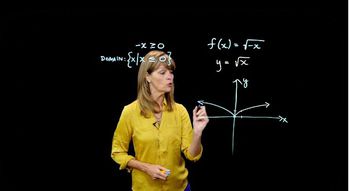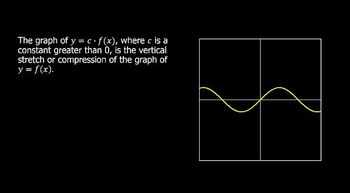Table of contents
- 0. Review of Algebra4h 16m
- 1. Equations & Inequalities3h 18m
- 2. Graphs of Equations43m
- 3. Functions2h 17m
- 4. Polynomial Functions1h 44m
- 5. Rational Functions1h 23m
- 6. Exponential & Logarithmic Functions2h 28m
- 7. Systems of Equations & Matrices4h 6m
- 8. Conic Sections2h 23m
- 9. Sequences, Series, & Induction1h 19m
- 10. Combinatorics & Probability1h 45m
3. Functions
Transformations
Problem 112
Textbook Question
In Exercises 107-118, begin by graphing the cube root function, f(x) = ∛x. Then use transformations of this graph to graph the given function. g(x) = (1/2)∛(x-2)
 Verified step by step guidance
Verified step by step guidance1
Start by graphing the basic cube root function, \( f(x) = \sqrt[3]{x} \). This graph passes through the origin (0,0) and is symmetric about the origin, with a general shape that increases slowly for negative x and more steeply for positive x.
Identify the transformations needed to graph \( g(x) = \frac{1}{2}\sqrt[3]{x-2} \). Notice that the function involves a horizontal shift, a vertical compression, and a vertical shift.
Apply the horizontal shift: The term \( x-2 \) inside the cube root indicates a shift to the right by 2 units. This means every point on the graph of \( f(x) = \sqrt[3]{x} \) will move 2 units to the right.
Apply the vertical compression: The coefficient \( \frac{1}{2} \) in front of the cube root function compresses the graph vertically by a factor of \( \frac{1}{2} \). This means that the y-values of the graph will be halved.
Combine these transformations to sketch the graph of \( g(x) = \frac{1}{2}\sqrt[3]{x-2} \). Start with the graph of \( f(x) = \sqrt[3]{x} \), shift it 2 units to the right, and then compress it vertically by a factor of \frac{1}{2}.
Recommended similar problem, with video answer:
 Verified Solution
Verified SolutionThis video solution was recommended by our tutors as helpful for the problem above
Video duration:
6mPlay a video:
Was this helpful?
Key Concepts
Here are the essential concepts you must grasp in order to answer the question correctly.
Cube Root Function
The cube root function, f(x) = ∛x, is a fundamental mathematical function that returns the number whose cube is x. It is defined for all real numbers and has a characteristic S-shaped curve that passes through the origin (0,0). Understanding its basic shape and properties, such as its domain and range, is essential for graphing and transforming the function.
Recommended video:

Imaginary Roots with the Square Root Property
Transformations of Functions
Transformations of functions involve shifting, stretching, compressing, or reflecting the graph of a function. For the function g(x) = (1/2)∛(x-2), the transformation includes a horizontal shift to the right by 2 units and a vertical compression by a factor of 1/2. Mastery of these transformations allows for the accurate graphing of modified functions based on their parent functions.
Recommended video:

Domain & Range of Transformed Functions
Graphing Techniques
Graphing techniques involve plotting points and understanding the behavior of functions to create accurate visual representations. For the cube root function and its transformations, it is important to identify key points, such as intercepts and turning points, and to understand how the transformations affect these points. This skill is crucial for effectively visualizing and interpreting the behavior of complex functions.
Recommended video:
Guided course

Graphs and Coordinates - Example

 5:25m
5:25mWatch next
Master Intro to Transformations with a bite sized video explanation from Nick Kaneko
Start learningRelated Videos
Related Practice

























